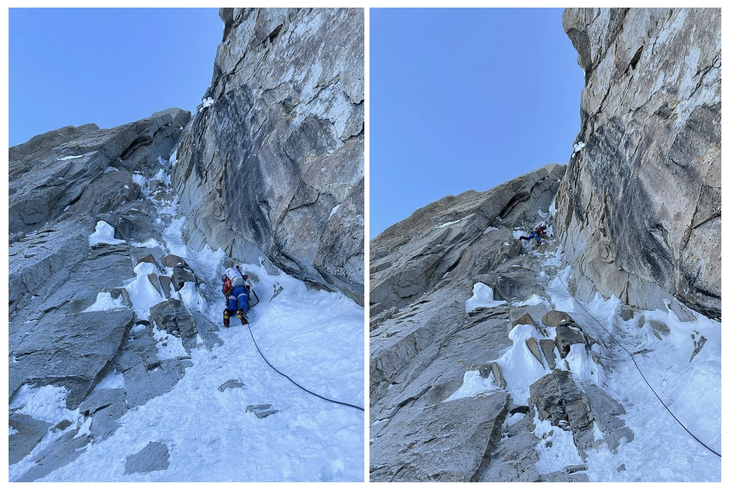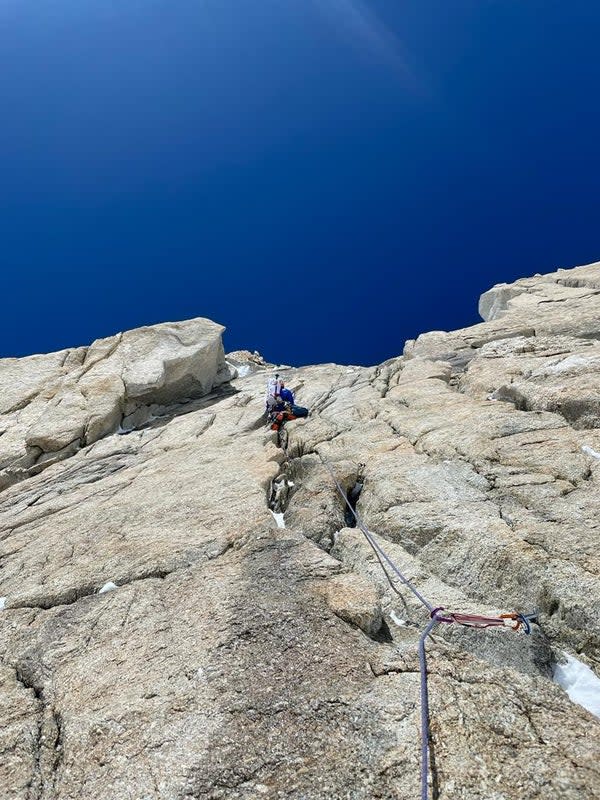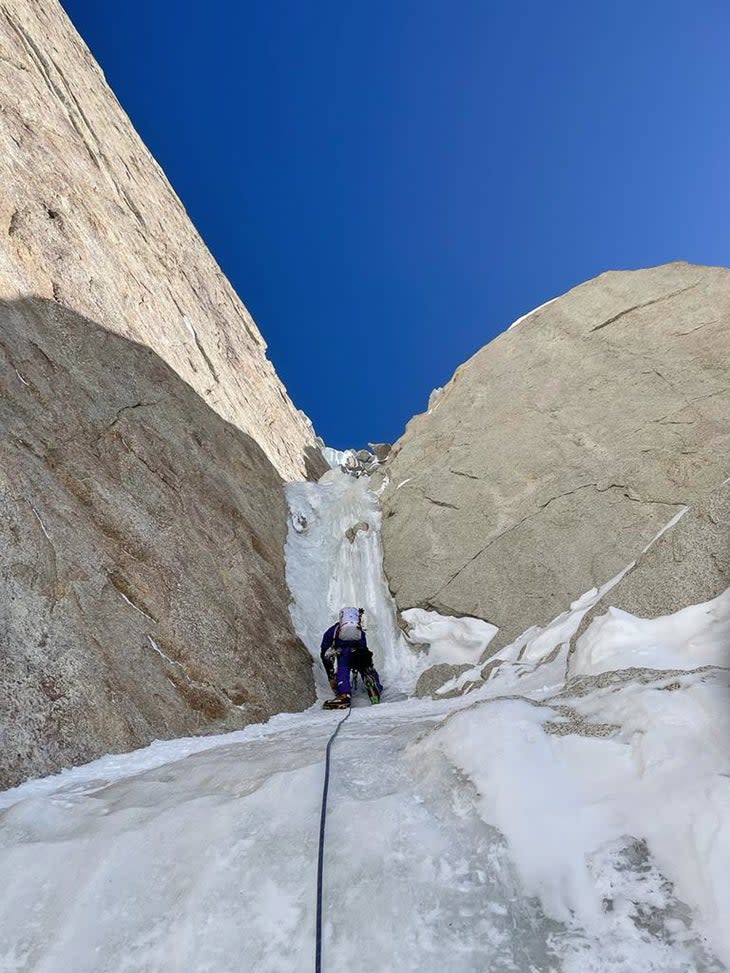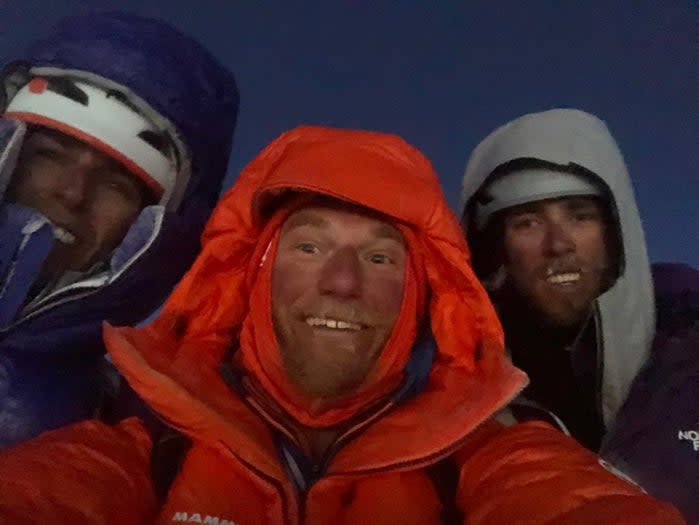Mind-Boggling Speed Ascent on the Famous “Slovak Direct,” Denali
This article originally appeared on Climbing
On May 20, Jackson Marvell, Alan Rousseau, and Matt Cornell completed one of the most legendary lines in North American alpinism, the Slovak Direct (VI 5.9X M6+ WI6 A2 9,000 feet) on Denali (20,310 feet) in a mere 21 hours and 35 minutes.
The iconic route, first climbed in 1984 by a Slovakian team of Blazej Adam, Tono Krizo, and Frantisek Korl over 11 days, is often considered the pinnacle of hard, sustained climbing on North America's highest peak. It's a committing line: overhanging ice at high elevation, runout rock pitches, and, by bringing a lean rack to facilitate a fast ascent, a near-impossible retreat from high on the face. As a result, the Slovak has seen less than a dozen ascents in its nearly 40-year history. Of particular note was a 2018 push by Chantel Astorga and Anne Gilbert Chase which marked the first all-female ascent (and only the second time an all-female team had climbed an Alaska Grade VI).
But the Slovak's proudest ascent is one that has stood for over two decades: a 60-hour blitz by legends Steve House, Mark Twight, and Scott Backes in 2000. Marvell, Rousseau, and Cornell's feat sliced that 60-hour push by two-thirds.

It's been a long time coming. "I've wanted to climb this ever since I started climbing in Alaska," Marvell told Climbing. In 2019, he and frequent partner Alan Rousseau began toying with the idea not just of tackling the Slovak, but trying to climb Alaska's Big Three (Mt. Hunter/Begguya, Mt. Foraker, and Denali), all in a single push via technical routes. "I guess we just wanted to see how fucked up we could get. How tired. How worked," Marvell said, laughing.
Plans were axed in 2020 due to the coronavirus pandemic, but in 2021 the duo fired the Moonflower Buttress on Hunter (14,573 feet) in 16 hours, then climbed Foraker (17,400 feet) via the Infinite Spur in 25 hours. The Slovak, however, remained elusive, largely because of the near-perfect conditions required. "We skied out to the base three times, but each time the weather was unsettled," Marvell said. "We didn't launch because we'd promised ourselves we wouldn't go for it without a perfect window." This year, Rousseau and Marvell returned for another stab at the Slovak, this time with a third, Matt Cornell.

Since 2019, the climbers have trained extensively for the route (which goes free at M8, but has yet to receive a free lead ascent), though Marvell noted that for him, at least, the gym training soon was replaced by "just climbing a lot." The team tested their skills on big rock together, too, completing benchmark Yosemite routes the Nose, Lurking Fear, and Zodiac all in a day (individually), the latter with Cornell in 2020.
Going into the Slovak, the team felt confident they could beat the 60-hour push made in 2000, estimating a schrund-to-summit time of at least 30 hours, but there was no effort to outdo House, Twight, and Backes' ascent.
"I would certainly say they provided inspiration," said Marvell, "and we wanted to see where we stacked up against their effort, but we weren't up there to try to beat them. We chose the route not because of their climb, but because the Slovak is supposed to be one of the best routes on Denali."
The team brought a single rack with doubles from 0.2 to 0.75, one #3 beak, 10 ice screws, eight quickdraws, a 60m 9mm rope, a tent, two sleeping pads, a down quilt, and a stove with one fuel canister.

After making the 10-mile ski approach the previous day, the team slept on the glacier, woke at 2:00 am, and crossed the bergschrund at 4:20. "From there it was game on," Marvell said. The team divided the route into three sections, each man leading one. Rousseau took the first block up to the bergschrund on the hanging glacier, Marvell led from the hanging glacier up to the base of the aid pitch (the section continuing most of the ice and mixed climbing) and Cornell led from the aid pitch to the crest of the Cassin Ridge (which serves as the Slovak's route to Denali's summit).
In total, the team belayed just three pitches, simul-climbing the rest of the 9,000-foot route. Cornell spent roughly an hour and a half attempting to free the aid pitch, where he took a short and controlled fall (with a piece at his waist) and switched to aid climbing. Rousseau and Marvell followed the pitch without any falls. Of their system, "We had the two followers tied in at [one] end of the rope with the second on a cow tail," Marvell said. "This enabled us to use micro traxions to protect the leader while we were simuling, keeping the micro in play longer with the second nearer to the end of the rope."
All told, Marvell said that the route went down without much of a hitch. "It went super smooth," he said. "The ice climbing was phenomenal. We were all dialed. We bonked a little bit up near the top, around 19,500 feet, and the pace slowed, but we kept it together....We all did our jobs, we took our blocks, that was that."
Marvell credits the smoothness of the Slovak to the team's ambitious attitude: "We were all highly motivated, we all wanted to see how fast we could do it, and we spent a ton of time talking strategy and defining our roles."
The result was a well-oiled machine that moved fast and hit hard, tackling one of the most notorious routes in the Alaska Range in a sliver of the fastest known time. "Honestly I thought we had to dig a lot harder when we did the Spur [on Foraker] last year. The climbing on the Slovak was much harder, but the Spur felt more adventurous."

Marvell and Rousseau have a long and tight-knit history climbing as a duo in Alaska, including a 2018 epic on Mt. Bradley (9,100 feet) which saw Rousseau hit in the eye by a shard of falling ice. Rousseau is essentially blind in that eye today (only able to see peripheral light), but if anything, the accident "lit the fire under our ass even more," Marvell said. "It built trust for us, knowing how we'd both react if shit hit the fan. He wears rated safety glasses when he climbs now, too" Marvell added, laughing.
But Cornell is a newer member of their team. His first experience climbing with Marvell was during the first ascent of a 23,000-foot peak in Pakistan, Sherpi Kangri II, alongside Kurt Ross in 2019. Marvell said that following the Slovak, he's excited about the new opportunities opened by climbing as a trio. "If you don't work through the up-front issues, [three people] is not a good system," he said. "But if you have the team dialed like we did, then it's more efficient, you can spread the weight between three people.
The three are so stoked on their system that they plan to head back to work on an unfinished objective of Marvell and Rousseau's in Nepal, the north face of Jannu (25,300 feet), this September. Rousseau was recently awarded a Cutting Edge Grant from the American Alpine Club to re-attempt the climb. "[The Slovak] proved to all of us that it's definitely feasible climbing as a team of three for these big, fast objectives. There is a little tweaking to do, like figuring out how to fit three dudes into two G7 pods for Jannu. But [after the Slovak] we realized we all have the right chemistry to make a team of three work. We just have to hit it hard."

Owen Clarke is a freelance writer living on the road. In addition to spending time in the mountains, he enjoys motorcycles, heavy metal, video games, and key lime pie.
For exclusive access to all of our fitness, gear, adventure, and travel stories, plus discounts on trips, events, and gear, sign up for Outside+ today.

